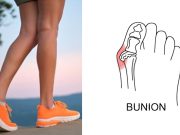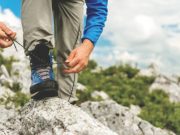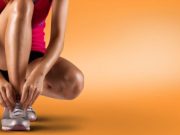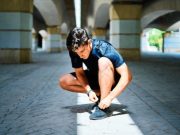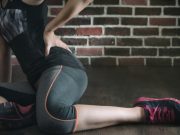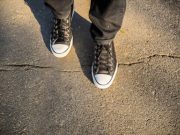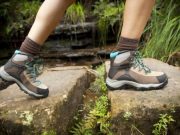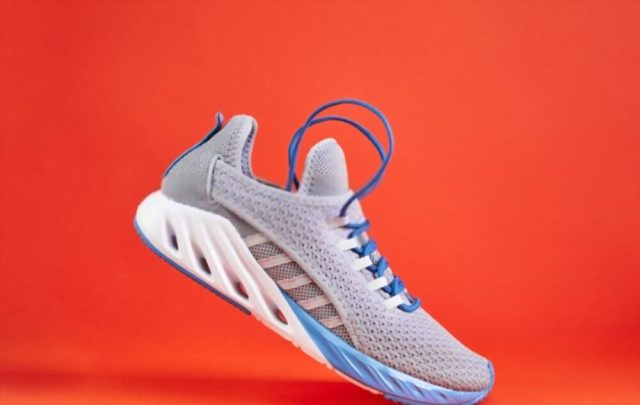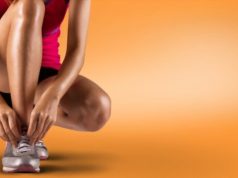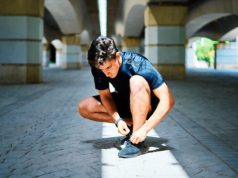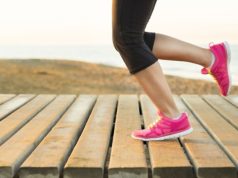When shopping for running shoes, there are several factors to consider. Firstly, the type of running shoe that’s right for you depends on your foot type and gait. In general, the best running shoe for most people is one that provides cushioning, stability, and flexibility. Look for shoes with a flat sole and stitch lines running the shoe length to indicate the intended foot shape.
Secondly, be sure the shoe fits properly and is not too tight or loose. Thirdly, when trying shoes on, ensure they feel comfortable on your feet and don’t cause any pain or irritation. Lastly, if you use orthotics or insoles while running, consider bringing those items with you to the store so you can get a better idea of the shape of your foot about the shoe. By taking these steps and paying attention to the details, you can find running shoes that are both functional and enjoyable. Let’s talk more about how to find good running Shoes.
Table of Contents
How to Find Good Running Shoes:
01: Choose the Right Type of Running Shoe
When choosing the right type of running shoe, it’s helpful to understand your foot type and running gait. Your foot type refers to the shape of your foot, as seen on a shoe-fitting diagram, while your running gait refers to how you run on the ground. Knowing your foot type can help you choose the right type of running shoe that best fits your needs.
Look for features such as wider toe boxes, neutral shoes, specific heel-to-toe drops, and energy return when shopping for a running shoe. For example, if you prefer stability in the heel region of your shoe, consider buying a pair of stability shoes with a low or medium heel height. If you prefer cushioning in the midfoot region of your shoe, consider purchasing a pair of cushioning shoes with some added cushioning or new technology in this area.
02: Consider Your Running Surface
When choosing a running shoe, consider the type of surface you will be running on. Some shoes are best for road running, providing cushioning and shock absorption to help prevent injuries. These shoes are ideal for those who prefer a smooth, flat surface and can’t be bothered with the trail.
Other shoes are designed for trails, offering grip, ankle support, and protection from uneven terrain. This type of shoe is best for those who enjoy running on varied surfaces and vary their running route often.
03: Midsole Shape
A running shoe midsole has the main role of providing cushioning and support to your feet as you run. A good running shoe midsole should have a foam layer for shock absorption. The thickness of the foam should be varied and comfortable on foot. A flexible arch-shaped midsole is preferred over a rigid one as it provides better cushioning and support to the foot.
The midsole should not be too thick or too thin to avoid achy joints. You can opt for a midsole with high cushioning and stability if you want a balance between the two properties. As the name suggests, the midsole absorbs the shock of running, which is vital for keeping your feet healthy, injury free, and stable during the run.
04: Heel-Toe Drop
To determine the heel-toe drop of a running shoe, the runner should go onto a flat surface and balance the shoe on the heel. He should then balance the shoe on the forefoot and adjust the height of the shoe as needed to reach a balance point. After doing this, the runner should step down with the foot as if running but with no force. This process is known as pruning out.
The more prone the foot becomes, the easier it will be to balance and run in that position. If pruning out doesn’t result in a comfortable balance, the runner can try pruning in by placing weight on their toes and lowering their knee to their hip joint. This is done to test how much cushioning is needed underfoot.
After proning out or proning in, the runner should stand up and walk around to test for stability and comfort.
The goal is to find a shoe with as little heel-toe drop as possible. Shoe companies offer shoes designed for different running surfaces and using different amounts of cushioning. Each type of shoe has its advantages and disadvantages, so it’s important to consider your preferences when choosing a pair of shoes for running.
05: Try a New Insole
Insole, also known as sock liners or footbeds, are removable pads inside running shoes that cushion the bottom contours of your feet. Aftermarket insoles can enhance comfort and support, especially for those with foot problems or who want to customize their fit. Different brands of running shoes have their proprietary foot model, or “last,” so an in-store fit session is key for a better fit.
Some lacing techniques can improve the fit of running shoes, such as the “Runner’s Loop,” which uses a loop of lacing to provide a snug but comfortable fit around the foot. To identify your gait type, look for wear on the inside, outside, or ball of the foot. This will help you choose the right running shoe for your stride style.
06: Heel and Forefoot Cushioning
Most running shoes are designed to balance cushioning and stability. The cushioning is intended to evenly distribute the impact of each stride, while the stability features are built in to provide the right balance of support and motion control.
The cushioning features of running shoes come in different varieties, such as heel cushioning, midsole cushioning, and toe cushioning. Each type of cushioning comes with its benefits and drawbacks. For example, heel cushioning is good for shock absorption and stability during high-impact running. On the other hand, midsole cushioning provides pronation control and absorbs shock waves during running.
07: Determine Your Foot Type
If you’re new to running, it’s important to know your foot type and what features might be useful as you start. A gait analysis can also help determine your foot type and running style. This involves having a professional assess the motion of your feet as you run on a track or treadmill, recording these measurements, and analyzing them to understand your running style and foot shape better.
Another way to find the best running shoe for your foot is to consider the running you will be doing. Factors to consider include the shoe’s cushioning and stability, as well as its width and heel-to-toe drop. A knowledgeable store staff can also help you make the right choice by pointing out features that may be useful, such as a wider toe box or a heel-to-toe drop.
Avoid Common Shoe-Buying Mistakes
Shoe shopping can be a daunting task, especially for new runners. It’s important to understand your individual needs when buying running shoes. Runners should replace running shoes every 400 to 600 miles to ensure shock absorption does not deplete. This is because the midsole material will become worn down over time, and the shoe won’t be as supportive as it once was.
If the staff at the store suggests a shoe you don’t feel comfortable wearing, then it’s best to listen to your gut. Going out of your comfort zone and trying new shoes to find the perfect fit is vital. This will help you find the most comfortable running shoes for your unique gait and foot shape. Avoiding common shoe-buying mistakes will help you find the perfect pair of running shoes for your feet and easy stride.
Types of Running Shoes :
When choosing running shoes, there are a few features to consider. The type of shoe you use will depend on the surface you’re running on and your foot type. The main categories of running shoes are neutral, stability, and motion control.
Neutral shoes: The neutral shoes are designed with flexible outsoles that allow a comfortable transition from heel to toe. They are best for people who want to wear their usual shoes while running.
Stability shoes: Stability shoes have sturdy outsole designs that provide support and stability over varied terrain. These shoes are best for experienced runners who want the extra stability and support of a more rigid shoe.
Motion-control shoes: The motion-control shoes have arch support, cushioning in the forefoot, and firm outsole designs for optimal control over the foot during running. These shoes are best for people who need extra stability and support while running.
Feel free to talk to a running store or online shoe retailer specialist about the shoes that would be best for you based on your foot type and running experience.
Which Type of Shoe is Best for Running in 2023?
With the popularity of running, it comes as no surprise that there are different options of shoes for running. There are road, track spikes, cross-training, and trail-running shoes.
You can wear regular road shoes for workouts and competitions on the road. These shoes provide good traction and support for running fast on the road. However, they have a different level of cushioning than those designed for track workouts or competitions.
01: Cushioned Shoes
Cushioned shoes can range from light foam to plush cushioning. Cushioned shoes are best for runners who supinate, as they provide support and help distribute the impact of running. Stability running shoes are for runners who experience overpronation and have low or flat arches. These shoes support the arch by distributing the weight evenly throughout the foot.
Plush shoes are great for recovery runs, providing cushioning and stability for the runner to ease back into running after a long break. However, plump shoes can cause low back pain if they cause the runner to relax their form too much. When shopping for running shoes, consider the cushioning and support needed for your foot shape and running style.
02: Maximal Shoes
Maximal shoes provide more stability than running shoes due to their larger base. They are often lightweight and have a lower heel-to-toe drop, ranging from 10mm to 6mm. This makes them taller and more stable than shoes with a lower heel-to-toe drop. Maximum cushion running shoes provide thick padding in the midsoles for the ultimate plush feel.
These shoes also feature a higher stack height, which means they are taller and wear longer than other running shoes. On the other hand, minimal cushion running shoes are favored by runners who want to feel their connection to the ground beneath them. These shoes typically have a low heel-to-toe drop of 5mm or less and offer minimal cushioning in the midsole for the runner’s barefoot feel.
03: Carbon Fiber Shoes
Comfort and stability are essential to running safely. Shoes that offer cushioning and stability can provide the right balance of support and cushioning for running smoothly. Carbon fiber shoes are designed to absorb shock and promote efficient foot movement, making them a popular choice for runners looking for lightweight and durable shoes.
Running shoes are vital for providing cushioning, flexibility, stability, traction, torsional stability, breathability, and reflectivity. Wearing the wrong running shoes can increase the risk of injury.
04: Minimal and Zero-Drop Shoes
For runners who suffer from ball of foot pain or overpronation, zero-drop shoes are the best type to choose. They have a flat sole without any elevation from heel to toe, making them ideal for running on a level cushioning. Low-drop or zero-drop shoes are perfect for runners who land on their toes. These shoes have a reduced rocker from the heel to the toe, providing support as the runner hits the ground. Stability shoes provide stability and support for flat-footed runners.
These shoes have a high arch and stability cushioning in the midsole to help support runners with flat feet that weigh over 180 pounds. On the other hand, motion-control shoes are designed to provide extra stability for runners with flat feet that under pronate and overpronate. These shoes have a more elevated midsole and thinner outsole to help provide extra support when running on uneven surfaces or landing on the balls of the feet.
Read More :
01: What to look for in running shoes?
02: What to do with old running shoes?
03: What is a neutral running shoe?
04: What is a drop in running shoes?
05: What is a Stability Running shoe?
06: How long do running shoes last?
Frequently Asked Questions:
How do I know what running shoes are best?
Before you even shop for running shoes, you’ll need to consider the running you plan to do. For example, if you’re mainly a road runner, you may need less cushioning than someone who runs on trails or in the mud. You should also consider the type of terrain you’ll be running on.
What are the 3 types of running shoes?
There are three main types of running shoes: motion control, cushioned, and stability.
Motion control shoes are designed to position the foot in a neutral stance to limit injuries and increase efficiency. They are perfect for runners who want to improve their performance but avoid overuse injuries.
Cushioned shoes offer a variety of preferences for speed, cushioning, or fit. These shoes can be worn for running on pavement or tracks and running outdoors on trails.
Stability running shoes provide flexibility, durability, and support. They are perfect for marathon runners, trail runners, and people who engage in other running that involves lots of running on uneven surfaces.
How much should I pay for good running shoes?
When it comes to choosing running shoes, you’ll want to budget between £80 and £120. This price range typically covers good quality running shoes that will last several months or years.
How to pick the right running shoes?
When selecting running shoes, consider the surface you’ll be running on. Running shoes are designed to fit different surfaces, such as pavement, grass, or trail. When considering the type of surface you’ll be running on, think about how often you’ll be running on it and the length of your run. Select a running shoe that fits your foot properly and feels comfortable.
Conclusion
Remember, running shoes are just as much a part of your outfit as the shirt or pants you wear. So make sure to choose running shoes based on the above factors and pick the perfect pair. Try out different running shoes to find the one that works best with your foot type and running style. Besides, ensure you get an accurate measurement of your feet while buying running shoes so that no mismatched pair is chosen.





